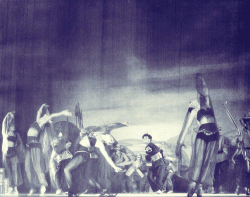 The national ballet of canada orchestra is coming out of the pit. As part of the National’s 60th anniversary season festivities, the orchestra will give a concert at Koerner Hall on April 3. While the orchestra loves the acoustics at the Four Seasons Centre, being in the pit is not the same as being on stage. The Koerner Hall concert in a prestigious recital hall is a very big deal. Says David Briskin, music director and principal conductor since 2006: “The concert celebrates the fact that the National Ballet has had a commitment to live music from the very beginning of its existence.”
The national ballet of canada orchestra is coming out of the pit. As part of the National’s 60th anniversary season festivities, the orchestra will give a concert at Koerner Hall on April 3. While the orchestra loves the acoustics at the Four Seasons Centre, being in the pit is not the same as being on stage. The Koerner Hall concert in a prestigious recital hall is a very big deal. Says David Briskin, music director and principal conductor since 2006: “The concert celebrates the fact that the National Ballet has had a commitment to live music from the very beginning of its existence.”
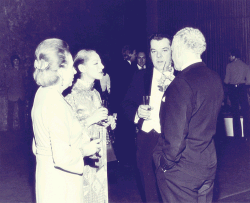 The creation of the National Ballet Orchestra is entirely due to the vision of company founder Celia Franca. By all accounts, music was very important to her because she was a gifted pianist. The very first National performance featured two pianos because Franca couldn’t afford an orchestra, but it set a precedent. One of the pianists-cum-conductor was George Crum who would become the National’s first music director. Briskin points to another sign that the orchestra has always been an important component of the National Ballet fabric. “Look at the company masthead,” he says. “The music director’s name is right up there with the artistic director and executive director.”
The creation of the National Ballet Orchestra is entirely due to the vision of company founder Celia Franca. By all accounts, music was very important to her because she was a gifted pianist. The very first National performance featured two pianos because Franca couldn’t afford an orchestra, but it set a precedent. One of the pianists-cum-conductor was George Crum who would become the National’s first music director. Briskin points to another sign that the orchestra has always been an important component of the National Ballet fabric. “Look at the company masthead,” he says. “The music director’s name is right up there with the artistic director and executive director.”
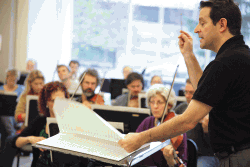 Jean Verch, orchestra personnel manager and music administrator, deems Briskin the most hands-on music director the company has ever had. “David is very pro-development and a strong advocate for the musicians,” she says. In planning the concert’s repertoire, Briskin poured over the archives. He ultimately chose music that is connected to one or another of the company’s artistic directors in some way. There will also be a visual component with famed actor Colm Fiore as host and narrator. Briskin is overseeing every detail of the concert.
Jean Verch, orchestra personnel manager and music administrator, deems Briskin the most hands-on music director the company has ever had. “David is very pro-development and a strong advocate for the musicians,” she says. In planning the concert’s repertoire, Briskin poured over the archives. He ultimately chose music that is connected to one or another of the company’s artistic directors in some way. There will also be a visual component with famed actor Colm Fiore as host and narrator. Briskin is overseeing every detail of the concert.
The concert is made up of ballet music. That’s a given, but Briskin has crafted an exciting line-up of 11 pieces that should show off his orchestra very well. For example, Borodin’s Polovetsian Dances is a tribute both to Franca and to the National’s very first performance at Eaton’s Auditorium on November 12, 1951, when the company presented Michel Fokine’s choreography to Borodin’s fiery music.
Erik Satie’s Gymnopédie No.1 honours Alexander Grant who brought Sir Frederick Ashton’s Monotones 11 into the repertoire. Tchaikovsky’s Russian Dance from Swan Lake is a tribute to both Erik Bruhn’s 1969 and James Kudelka’s 1999 versions of the famed ballet. Karen Kain is represented by Joby Talbot’s Alice’s Adventures in Wonderland Suite, composed for Christopher Wheeldon’s 2011 world premiere. There are also excerpts from works by Prokofiev, Stravinsky, Léo Délibes, Ludwig Minkus and Leonard Bernstein.
: : :
At times, musicians tend to see music very differently from dancers. Clarinettist Max Christie tells about a conversation he had with former ballerina Kimberly Glasco. “I said that La Bayadère might be a fantastic showcase for dancers, but that the Minkus music was lame in comparison to Tchaikovsky. She, on the other hand, loved the music and thought it was beautiful. Meanwhile, we play it for what it is — trite music meant strictly for dance.” Even Adolphe Adam’s Giselle, an iconic ballet classic if ever there was, comes in for a drubbing. Says Christie: “It’s semi-monochromatic, and almost static. You can’t make a suite of the music for the concert stage.”
On the other hand, Tchaikovsky’s Sleeping Beauty is “terrifying.” “It never lets up,” explains Christie. “I have to practise for it.” Similarly, The Nutcracker remains a challenge even though it repeats every year. “The music is really hard,” he says. “Tchaikovsky had a knack for finding difficult things for an orchestra to do.” Christie calls Prokofiev’s Cinderella fun because it contains “wicked stuff for the clarinet.” Joby Talbot’s score for Alice’s Adventures in Wonderland is a “giggle” because of all the great orchestral sound effects.
Violinist Sonia Klimasko-Leheniuk believes that choreographers are choosing higher quality music, which has led to better technique among the orchestra members. “Choreographers are becoming more discerning, particularly about new music,” she says. She singles out Alexei Ratmansky’s ballet Russian Seasons set to Leonid Desyatnikov’s 2000 score. “Now that was exciting to play,” she says.
All this talk about repertoire raises another question. What precisely distinguishes a ballet orchestra from other musical ensembles? Trumpeter Raymond Tizzard is the orchestra’s assistant personnel manager. Says Tizzard: “Our greatest skill is flexibility and the ability to turn on a dime. Ballet is an extremely complex art form. An ideal ballet orchestra balances the needs of the dancers, choreographers and composers to the satisfaction of them all. For example, the orchestra will play differently for each different cast. The audience may not be aware of the subtleties but the orchestra knows.”
In other words, the musicians must observe the conductor so closely that Briskin can signal the most minute changes in tempo which the orchestra will immediately execute. “The conductor connects music to movement,” explains Briskin. “I pass on to the musicians a picture of what is happening on stage.”
Magdalena Popa is the principal artistic coach who works specifically with the principal dancers. When the dancers have learned the role in terms of technique and choreography, and are almost ready for the stage, Popa calls Briskin into the studio. Briskin then conducts the rehearsal pianist according to tempi set by Popa and the dancer in consultation with himself. He is there to represent the composer. Any conflict over tempi is worked out in the rehearsal studio. It’s the dry run before he brings the tempi to his orchestra. Says Popa: “I trust David completely. He looks at me and instantly picks up the fine nuance needed in the music. Only a good conductor can do this.”
Whether for an established or a new ballet, Briskin must know the choreography intimately. He also must learn the physical idiosyncrasies of the individual dancers, even anticipating how they will move on stage. Which brings us to the thorny problem of tempi. Briskin says that every ballet conductor is the butt of the old joke where a dancer says, “I don’t want it too fast or too slow. I want it just right.” The problem is, what is just right? In fact, talking to the National dancers, one finds out the major topic of discussion before, during and after a performance is tempi.
Take for example the male variation in the Blue Bird pas de deux from The Sleeping Beauty. The dancer is literally in the air more than he is on the ground. As first soloist Etienne Lavigne explains, the conductor has to know each dancer’s specific jump. If the dancer can do a very high jump, the music slows down to give the dancer more time in the air. If another dancer’s skill is a consistent jump with a lightness in the landing, or ballon, the tempo has to speed up so that he lands exactly on the music. Says Lavigne: “There are stories out there about conductors sabotaging a dancer by making the tempo too fast or too slow.”
Briskin sees his role as manipulating time, rather than manipulating music. “We don’t make radical changes, but modifications,” he says. “The music is rephrased to suit the dancers. It’s different for the corps de ballet, where the music must be consistent because that’s what keeps them together.”
Principal dancer Heather Ogden gives examples of time modification. “In act one of Sleeping Beauty, Princess Aurora is a teenager, and I like the music to be fast, nippy and springy to capture her youthful energy. In the last pas de deux in Onegin, Tatiana at first resists Onegin’s pleas of love, but her will finally begins to break down. If the tempo is too fast, the dancer can’t show the unfolding of this inner struggle properly.”
The dancers, in fact, genuinely appreciate the orchestra. They understand how terrible the loss of live music would be. Principal character artist Tomas Schramek likes sitting in the pit during a performance so he can be cocooned in the music. “The orchestra is always an inspiration,” he says. “The music makes me want to dance more.”
And from Lavigne: “If the dancers are the body, the orchestra is the soul.”
UNWELCOME VISITORS, or The Perils of Being a Pit Band
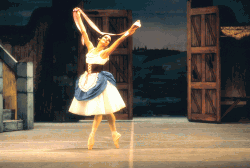 The National Ballet of Canada Orchestra has its own folklore, particularly about falling objects, human or otherwise.
The National Ballet of Canada Orchestra has its own folklore, particularly about falling objects, human or otherwise.
During a performance of Grant Strate’s House of Atreus in 1965, Howard Marcus landed on top of William Findlay’s cello and broke the neck scroll. Findlay gamely played on with one string.
In 1983, during Celia Franca’s The Nutcracker, a young Martine Lamy’s vision was obstructed by her Gingerbread costume (a total body suit). She ended up breaking a flute in half.
While not quite a fall, but a flutter, there was the matter of the real pigeons used in Frederick Ashton’s ballet The Two Pigeons in 1972. Attracted by the light glinting off Jean Verch’s flute, a pigeon landed on her hand. Apparently the musical vibrations encouraged the pigeon to leave bird droppings running down her arm.
As for objects, a rolling haystack (1992) from Ashton’s La Fille mal gardée caused a cellist to be off work for two years with an injured wrist. A wayward cabbage (1982) from the same ballet dented a trombone slide. In the fight scene of John Cranko’s Romeo and Juliet, the tip of a sword (1976) broke off and went through an oboe player’s cheek.
The most spectacular fall of all concerns Veronica Tennant and Clinton Rothwell at Artpark in upstate New York in 1981, during a performance of Fille (clearly the bad luck ballet). Her regular partner, Tomas Schramek, dislocated a finger in a baseball game due to Frank Augustyn’s errant throw. Rothwell was the cover.
Says Tennant: “It was during the ‘Wedding pas de deux.’ Clinton had me in a full overhead lift and my long dress was covering his head. One of his feet went off the stage and we dropped 18 ft. He held me all the way down, and my mother said later I was smiling all the way. I was unscathed because I landed on Clinton. He had a cracked coccyx.”
What saved the dancers from a worse fate was the quick thinking of violinist Andrea Hansen. When she realized what was happening, Hansen got the other players to help her clear away the music stands, chairs and instruments to create an open landing pad.
LEGENDARY STORIES
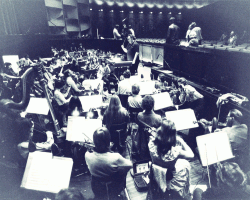 To achieve legendary status, an event has to be of epic proportions. Here are two National Ballet Orchestra stories that will never be forgotten.
To achieve legendary status, an event has to be of epic proportions. Here are two National Ballet Orchestra stories that will never be forgotten.
The National Arts Centre, Ottawa, 1969
The National Ballet was invited to perform Cranko’s Romeo and Juliet to launch the opening of the NAC. Constructed to be state-of-the-art, the orchestra pit is comprised of separate pods that can be raised or lowered to accommodate various ensemble sizes, at various levels of height.
During the performance, the operating mechanism broke down and pods began moving up and down at will. Miraculously, no one was injured, but musicians placed over the cracks between the pods had to cling for dear life as chairs and music stands tumbled around them. The conductor pod rose 12 ft. into the air, and a review at the time duly noted “maestro George Crum’s portly figure rising majestically above the stage.”
The Playhouse, Fredericton, 1978
Once again, the company was performing Ashton’s infamous La Fille mal gardée. Unfortunately, there was no pit although the theatre had just been renovated. The orchestra was put in a boiler room/bunker under the stage, accessed through a trap door and a circular staircase.
In order for George Crum to conduct the orchestra, a hole had been drilled into the side of the stage for his arm to fit through. Crum stood on the floor, with his nose at the end of the stage and his eyes tilting upward to see the dancers. He was wearing a woman’s long white opera glove to make his arm more visible in the gloom of the bunker.
As stage manager Ernie Abugov slammed the trap door shut on the orchestra, he shouted: “Row you bastards!”
And finally, a delightful story about the orchestra from former principal dancer Jocelyn Terell (1956–1964)
“I was 16 when I joined the company. The only reason my father let me go was because he believed all men associated with ballet were gay. He presumed I was safe, but he forgot about the orchestra. On tours in particular, ballerinas would date members of the orchestra. One musician told me that when Celia Franca got wind of a romance, she’d tell the guy, ‘Don’t get my dancer pregnant!’ She wasn’t thinking of us so much as the fact that she needed every dancer.” —Paula Citron



